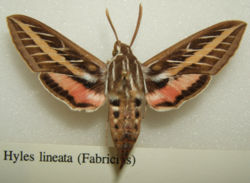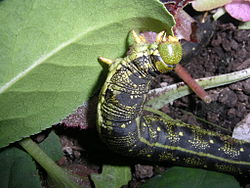- Hyles lineata
-
White-lined sphinx 
Hyles lineata, adult 
Hyles lineata, larva Conservation status Scientific classification Kingdom: Animalia Phylum: Arthropoda Class: Insecta Order: Lepidoptera Family: Sphingidae Genus: Hyles Species: H. lineata Binomial name Hyles lineata
(Fabricius, 1775)[1]Synonyms - Sphinx lineata Fabricius, 1775
- Celerio lineata
- Deilephila lineata
- Sphinx daucus Cramer, [1777]
- Sphinx lineata americana Laporte, 1830
- Celerio lineata florilega Kernbach, 1962
- Celerio lineata lineatoides Gehlen, 1934
The White-lined sphinx (Hyles lineata) is a moth of the Sphingidae family. It lives from Central America, through the United States and into parts of Canada.
Contents
Description
The fore wing is dark brown with a tan stripe which extends from the base to the apex. There are also white lines that cover the veins. The black hind wing has a broad pink median band. It has a wingspan of 2 to 3 inches.[2]
Flight
The White-lined sphinx may be encountered from April to October.[2]
Range
The moth's range is throughout the United States and extends north into southern Canada and south into Mexico. It can also be found occasionally in the West Indies.[3]
Life cycle
The larva is yellow and black or sometimes lime green and black. Many individuals have a subdorsal stripe. The head, prothoracic shield, and the anal plate are one color either green or orange with small black dots. The horn varies from either yellow or orange and sometimes has a black tip.[4] Larvae burrow into soil to go into chrysallis, where they remain for 2–3 weeks before they emerge as adults.
Host Plants
The adult of this species is a key pollinator of the rare lemon lily (Lilium parryi) in California.[5]
The caterpillars of this species eat:
- Willow weed (Epilobium)
- Four o'clock (Mirabilis jalapa)
- Apple (Malus)
- Evening primrose (Oenothera)
- Elm (Ulmus)
- Grape (Vitis)
- Tomato (Lycopersicon)
- Purslane (Portulaca)
- Fuchsia
Gallery
References
- ^ "CATE Creating a Taxonomic eScience - Sphingidae". Cate-sphingidae.org. https://www.cate-sphingidae.org/taxonomy/Hyles/lineata.html. Retrieved 2011-10-25.
- ^ a b Charles V. Covell, Jr. (1984, 2005). Moths of Eastern North America. Virginia Museum of Natural History, Martinsville, VA. ISBN 1-884549-21-7
- ^ "Butterflies and Moths of North America | collecting and sharing data about Lepidoptera". Butterfliesandmoths.org. http://www.butterfliesandmoths.org/species?l=3477. Retrieved 2011-10-25.
- ^ David L. Wagner (2005). Caterpillars of Eastern North America. Princeton University Press, Princeton, NJ. ISBN 0-691-12144-3
- ^ "''Lilium parryi''". Center for Plant Conservation. http://www.centerforplantconservation.org/ASP/CPC_ViewProfile.asp?CPCNum=2549. Retrieved 2011-10-25.
External links
- White-lined sphinx Butterflies and Moths of North America
- Hyles lineata lineata Sphingidae of the Americas
This Macroglossini-related article is a stub. You can help Wikipedia by expanding it.









